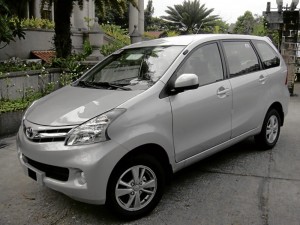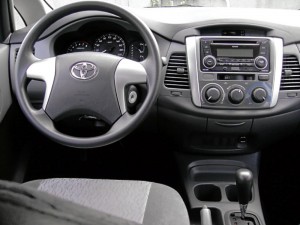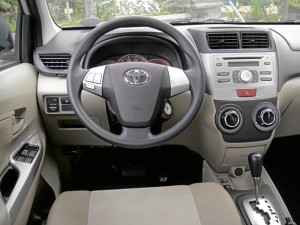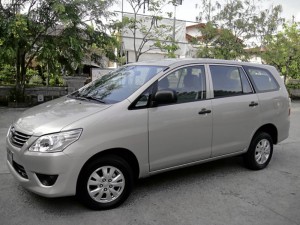Toyota’s small and medium MPVs
One reason why Toyota Motor Philippines Corp. (TMP) continues to dominate the automotive industry in sales is that it has a car to fit every buyer’s budget and needs. As of this date, TMP offers 16 different models ranging from the smallest compact, the Yaris, to the largest minivan, the Hiace—with a sports car, the legendary 86, being the latest addition (although this year’s TMP allocation of the 86 has been presold entirely.) Thus, among the Asian car manufacturers operating in the Philippines, TMP has the widest variety of rides to choose from. And if you can afford a luxury vehicle, there is Toyota’s premium division, Lexus Manila.
Recently, I got to test-drive, individually and during different weeks, two of TMP’s bestselling models: the 2012 Avanza and the 2012 Innova. The Avanza and the Innova are sibling MPVs (multipurpose vehicles) in small and medium sizes.
2012 Avanza
The Avanza was developed in Indonesia and introduced in the Philippines in 2006. It is manufactured in Indonesia, where MPVs rule the road.
The second-generation Avanza looks almost exactly the same as the first. The interior appears more upscale with a redesigned dashboard, optitron meters and a small LCD information display. The steering wheel now has audio controls and the steering column can be adjusted for tilt. Access to the third row seat has been improved, also air flow thereto.
The Avanza I test-drove had a gasoline-fed 1.5-liter VVT-i 4-cylinder DOHC, 16-valve engine with electronic fuel injection producing a rather tepid 102 hp/6000 rpm and 136 Nm 4400 rpm max torque. The transmission was a 4-speed gate-type automatic (A/T). The Avanza is also available with a 1.3-liter engine. You can choose a 4-speed A/T or a 5-speed manual transmission (M/T), whichever variant you buy, 1.5 or 1.3.
The suspension system, consisting of MacPherson strut with stabilizer in front and 4-link at the rear, has coil springs fore and aft. The brakes are discs in front and leading-trailing drums at the rear on 15-inch alloy wheels. This arrangement contributes to nice driveability. Because of rear wheel drive, the Avanza has a small minimum turning radius.
In other emerging markets, the Avanza is offered with either a gasoline or a diesel engine—but not here. Too bad, for there are reports that the 1.5 Avanza is a thirsty little MPV. If TMP were to bring in the diesel Avanza, it would enjoy the advantage of being the only diesel compact MPV in the Philippines, the Hyundai Matrix having left the market several years ago.
Nonetheless, with its 7-seater capacity and highly rigid chassis, Toyota’s budget MPV would make a good choice for a young, growing family with two or three kids already. The 1.3 Avanza 5-seater M/T is logical for taxicab use. The 1.5 A/T Avanza sells for P868,000 while the M/T is yours for P828,000. Prices for the 1.3 Avanza models range from P620,000 for the 5-seater M/T to P743,000 for the 8-seater A/T.
2012 Innova
The Innova, one of the three vehicles that represented the new wave—Toyota’s Innovative International Multipurpose Vehicle (IMV) program (the others were the Hilux and the Fortuner)—replaced the Revo in 2005. It is proudly made by TMP in Santa Rosa, Laguna and exported to other Asean markets.
The 2012 iteration of the Innova is its second facelift, featuring new, angular headlights, a new trapezoidal front grille, a restyled front bumper with integrated fog lamps, new, bulging taillights, a redesigned rear bumper with reflectors, new 9-spoke alloy wheels and chrome side mirrors and door handles.
Inside, there is a new dashboard, a touchscreen display for audio, DVD and Bluetooth functions, optitron meters, automatic climate control, a 4-spoke, leather-wrapped steering wheel with audio and multi-info display controls, rear ceiling air conditioner and bigger luggage space.
From the very first day it was introduced, the 8-seater, rear-wheel-drive Innova became the country’s best-selling medium-sized affordable MPV, quickly replacing the Revo in the hearts of loyal Toyota customers. Then as now, the Innova was offered with either a diesel or petrol engine: the direct injection 4-stroke common rail diesel (D-4D) 2.5-liter, 4 cylinders in-line, DOHC turbocharged powerplant or the 2.0-liter VVT-i, 4 cylinders in-line DOHC 16-valve gasoline engine.
The engines are mated to either a 4-speed gate-type A/T with ECT (Electronic Control Transmission) or a 5-speed M/T. Max output of the D-4D Innova is claimed to be 102 ps/3600 rpm with peak torque reaching 260 Nm/ 1600-2400 rpm in the A/T and 200 Nm/ 1400-3200 rpm in the M/T. Sharing the same platform as the Hilux and Fortuner, the Innova has an independent coil spring front suspension and double wishbone with stabilizer bar, 4-link coil springs at the rear. The 15-inch alloy wheels are fitted with ventilated disc brakes in front and leading trailer-drums at the rear. Being an IMV [Innovative International Multipurpose Vehicle] like the Hilux and Fortuner, the Innova has dual front airbags and ABS (high-end variants only).
The reliability and durability of the Innova can be discerned from the many units that you see on the road every day, belonging to different model years. It is a sturdy family or people carrier although being truck-based, riding comfort in the back seats is compromised. On the other hand, its truck underpinnings make the Innova really strong. Prices range from P818,000 for the 2.0 gas M/T Innova J to P1.240 million for the 2.5 diesel A/T white pearl Innova G.
Summing up, the Avanza and Innova both offer good value for money.





